FRIDAY, AUGUST 25
■ How soon after dusk can you make out the big Summer Triangle? Face east. Vega, the Triangle's brightest star, is nearly at the zenith (for skywatchers at mid-northern latitudes). Deneb is the first bright star to Vega's east-northeast. Altair shines less high in the southeast.
■ As the evening grows darker, pick out the star-pattern of Scorpius curling below the Moon, as shown below.
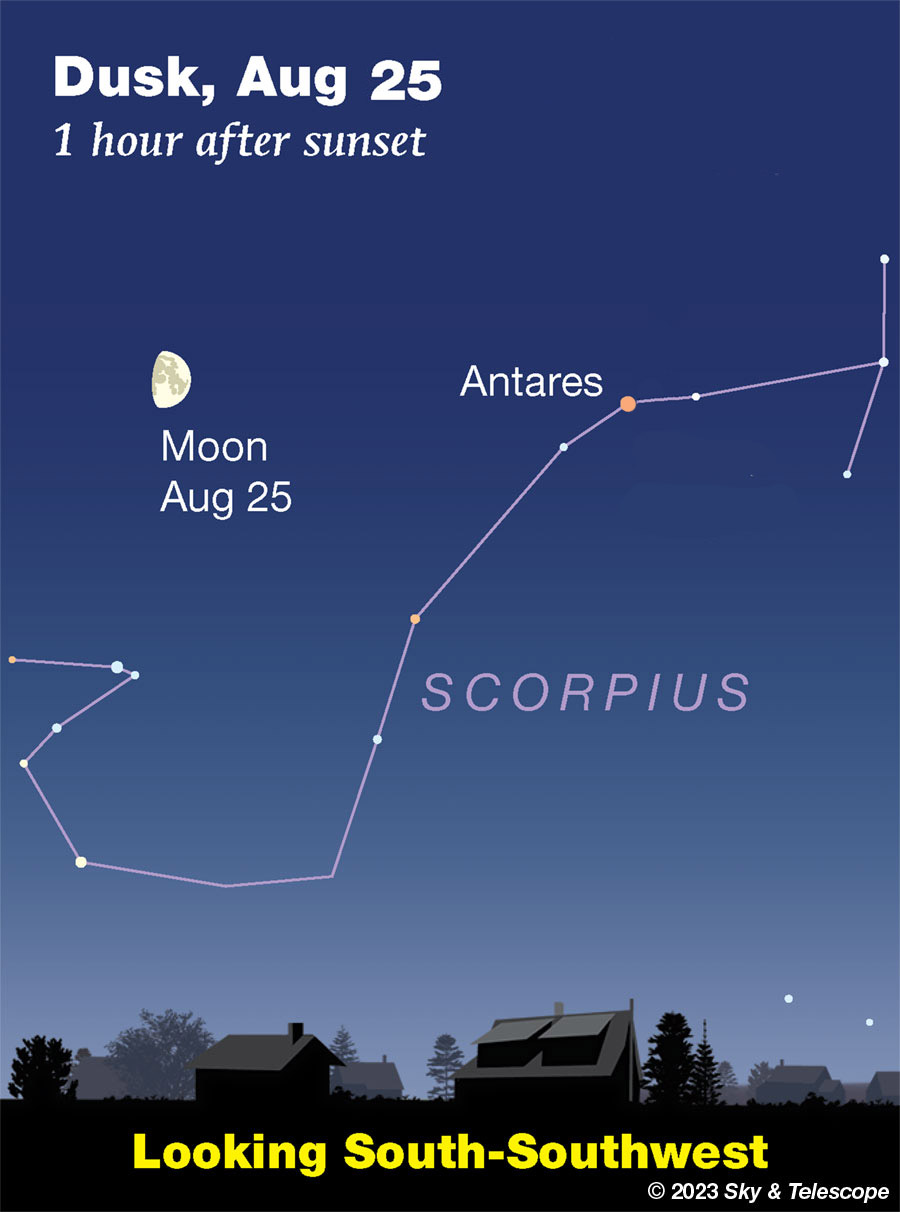
SATURDAY, AUGUST 26
■ Saturn is at opposition tonight (exactly so at 4 a.m. on the 27th EDT). In a telescope, do you notice that Saturn's rings are distinctly brighter, compared to Saturn's globe, than you usually see them? This is the Seeliger effect, caused by the solid ring particles backscattering sunlight to us when the Sun is almost directly behind us. The dusty surfaces of the Moon and Mars also display this "opposition effect," but Saturn's clouds do not. In the case of Saturn the effect is named for Hugo von Seeliger, who studied it in detail and published his findings in 1887.
The brightening begins several days before Saturn's opposition, is most apparent right around that date, and fades for several days after.
SUNDAY, AUGUST 27
■ The waxing gibbous Moon shines in the south after dark. High above it, by three or four fists at arm's length, spot 1st-magnitude Altair with its little sidekick, 3rd-magnitude Tarazed (Gamma Aquilae) about a finger-width above it.
Much closer to the right of the Moon is the Sagittarius Teapot. Its four-star handle is the part of the Teapot closest to the Moon: less than a fist at arm's length. About a fist to the right of the handle, and perhaps a bit lower, is the Teapot's spout. Binoculars help through the moonlight.
MONDAY, AUGUST 28
■ Different people have an easier or harder time seeing star colors, especially subtle ones. To me, the tints of bright stars stand out a little better in a sky that's the deep blue of late twilight.
For instance, the two brightest stars of summer are Vega, nearly overhead at dusk, and Arcturus shining in the west. Vega is white with just a touch of blue. Arcturus is pale yellow-orange. Do their colors stand out a little better for you in late twilight? Could this be a color-contrast effect of seeing yellow, orange, or orange-red stars on a blue background?
Vega is a white-hot, type-A star. Arcturus is a less hot, type-K giant.
TUESDAY, AUGUST 29
■ After the Sun sets in the west-northwest, turn around and look on the opposite side of the sky for the low Moon, just a day from full. As the sky dims and the Moon climbs higher, how soon tonight can you see Saturn coming into view to its left as shown below?
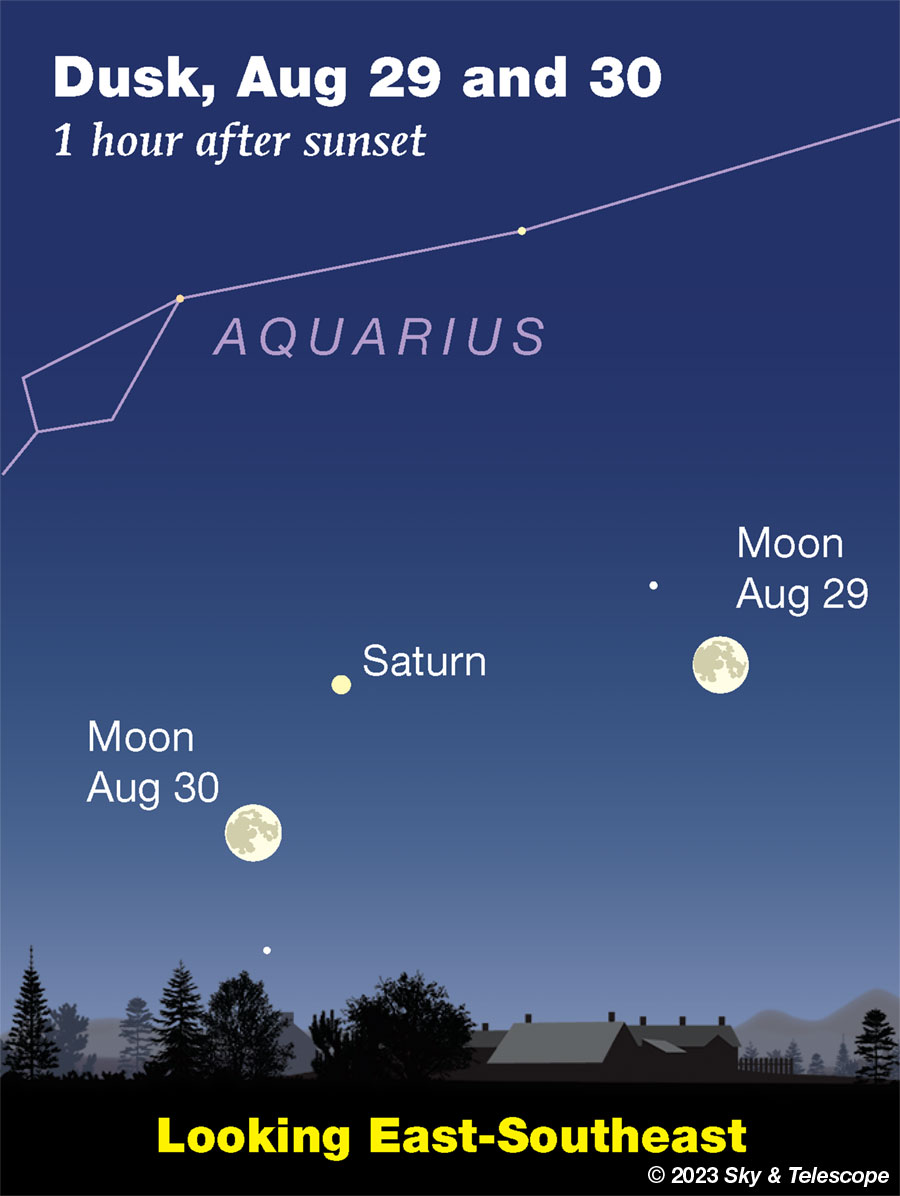
WEDNESDAY, AUGUST 30
■ Full Moon (exactly so at 9:36 p.m. EDT). Writes Gianluca Masi, "The 31 August full Moon will be the third supermoon of 2023, but it will be the largest of the year. In addition, being the second full Moon of this month, it is also a so-called blue moon. Having two supermoons in the same month is relatively rare: last time was in 2018, next time will be in 2037."
Saturn accompanies the Moon across the sky tonight. Saturn seems to swing from upper right of the Moon at dusk, as shown above, to directly right of the Moon by about 1 a.m., then lower right of the Moon as the hours approach dawn.
THURSDAY, AUGUST 31
■ A winter preview. Step out before the first light of dawn begins this week (about two hours before sunrise), and the sky displays the same starry panorama it does at dinnertime around New Year's. Orion is striding up in the east-southeast, with Aldebaran and then the Pleiades above it. The Gemini twins are lying on their sides to Orion's left, well up in the east. Capella beams from high in the east-northeast. Vega is settling down low in the northwest.
FRIDAY, SEPTEMBER 1
■ Just after twilight fades away, look for bright Vega passing near the zenith (if you live in the world's mid-northern latitudes). Vega goes right through your zenith if you're at latitude 39° north: near Baltimore, Kansas City, Lake Tahoe, Sendai, Beijing, Athens, Lisbon.
■ As dawn brightens, catch Venus now rapidly emerging in the east from its conjunction with the Sun. In a telescope or even good binoculars it's a thin crescent, just 11% sunlit.
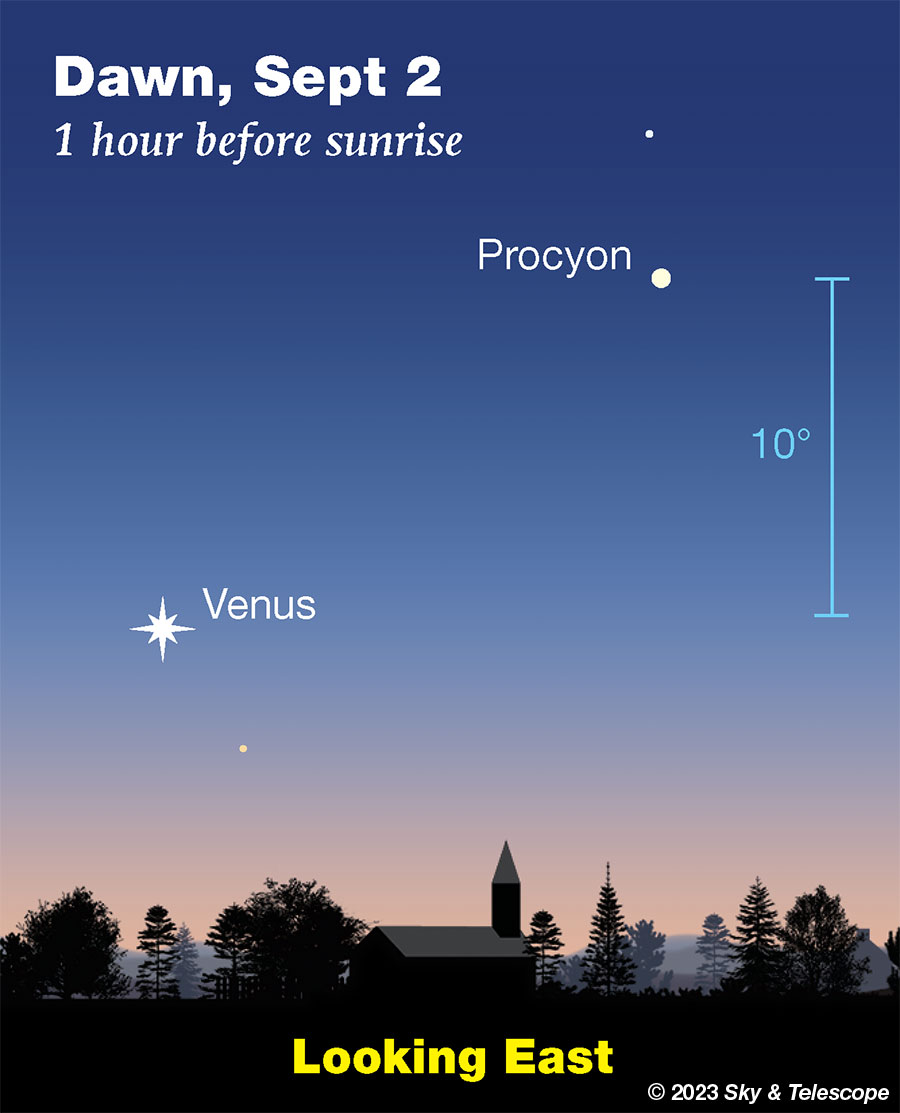
SATURDAY, SEPTEMBER 2
■ The two brightest stars of September evenings are Vega high overhead and Arcturus in the west, both magnitude 0.
Draw a line from Vega down to Arcturus. A third of the way down you cross the dim Keystone of Hercules. Two thirds of the way you cross the dim semicircle of Corona Borealis displaying its one modestly bright star: Alphecca, the gem of the crown.
SUNDAY, SEPTEMBER 3
■ A late-night telescope session tonight offers the Moon in its interesting waning gibbous phase, with lunar landforms near the terminator casting their shadows in the opposite direction from when the Moon is a thick waxing crescent seen in early evening.
Then switch to Jupiter shining right nearby, as shown below. Jupiter's four bright Galilean moons are very roughly the size of our own Moon, but at 1,800 times the distance, they appear in a telescope as hardly more than pinpoints.
Jupiter's Great Red Spot should transit the planet's central meridian tonight around 1 a.m. EDT.
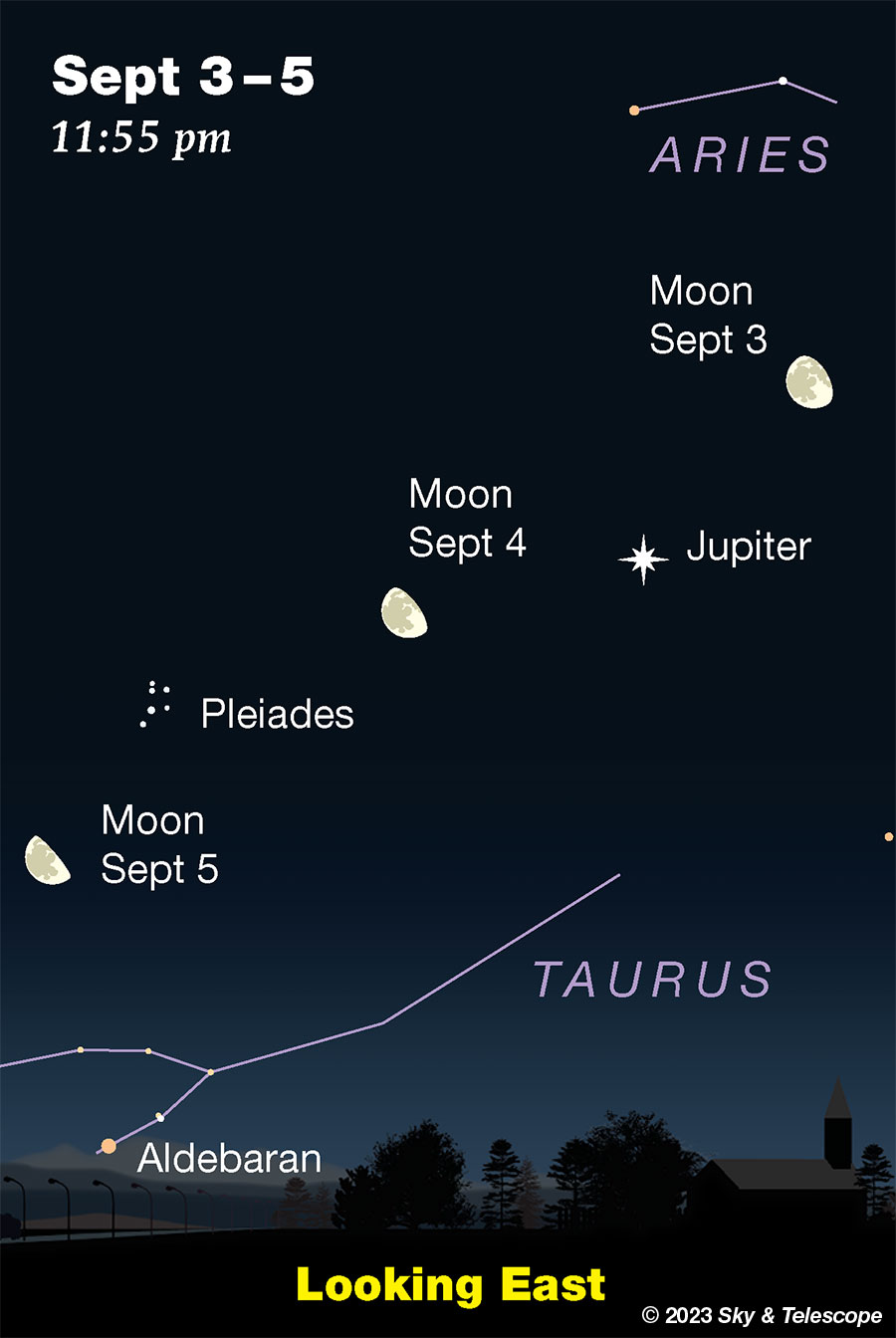
This Week's Planet Roundup
Mercury and Mars are lost in glow of sunset.
Venus (about magnitude –4.6) is fast emerging low in brightening dawn. Look for it above the horizon due east. It gets higher and easier every day.
Even low magnification shows that Venus is again a thin crescent. The crescent will get thicker and smaller in the coming weeks as it climbs higher in the dawn, the reverse of how it grew thinner and larger while heading down into the sunset in July.
Jupiter (magnitude –2.6, in Aries) rises about an hour after full dark. Watch for it to come up low in the east-northeast. Jupiter shines highest in the south just before the beginning of dawn.
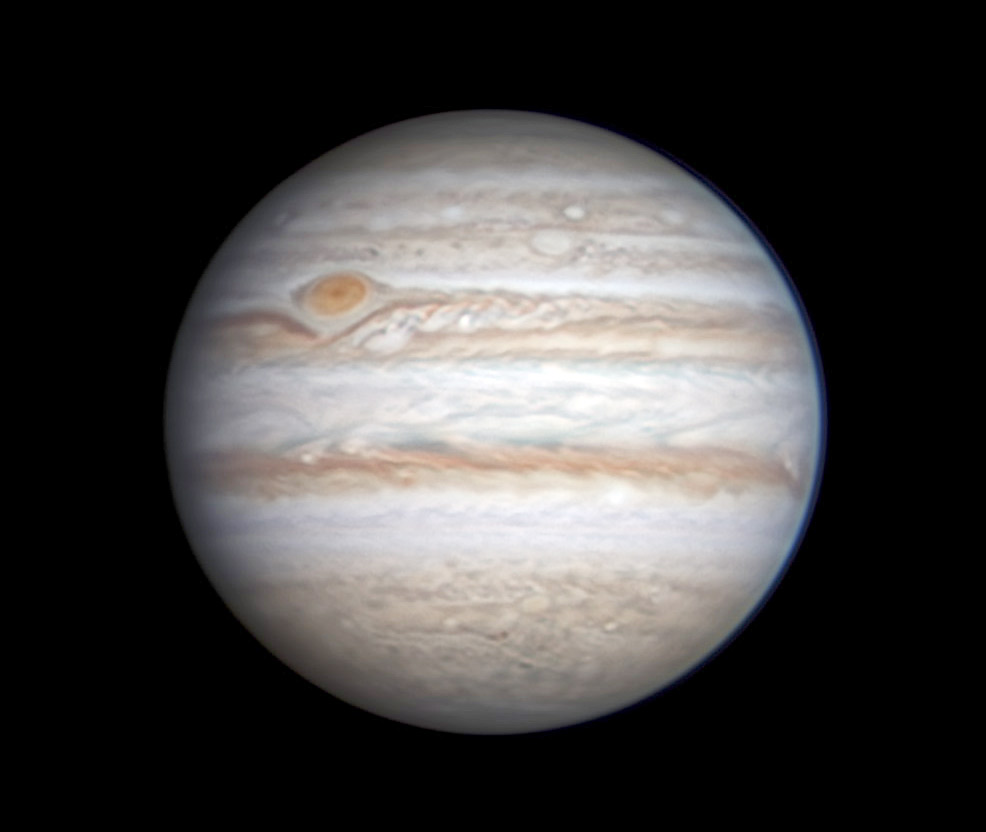
Saturn (magnitude +0.4, in dim Aquarius) rises at sunset; it's at opposition this week, on August 26th. In late twilight you'll find Saturn glowing as the brightest thing low in the east-southeast. It's at a fairly good height for telescopic observing by 11 p.m. (by which time Fomalhaut is twinkling two fists below it). Saturn is at its highest in the south around 1 a.m.
Watch for the Seeliger Effect to diminish on Saturn's rings this week; see August 26th above.
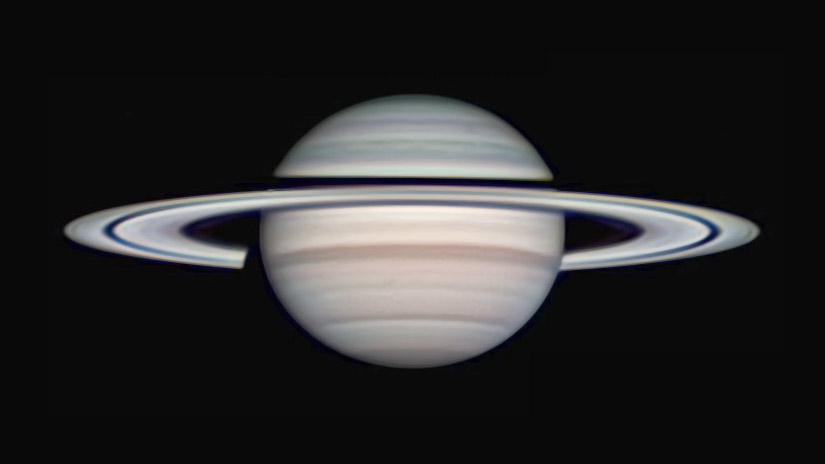
Currently Saturn is at opposition, so the shadow of the globe on the rings behind (the black gap at the lower left here) has disappeared from view; Saturn's shadow is now directly behind it from Earth's point of view.
Uranus, magnitude 5.7 in Aries, is nice and high by midnight, 7° or 8° east of Jupiter.
Neptune, magnitude 7.8 at the Aquarius-Pisces border, is fairly high by late evening, 23° east of Saturn.
All descriptions that relate to your horizon — including the words up, down, right, and left — are written for the world's mid-northern latitudes. Descriptions and graphics that also depend on longitude (mainly Moon positions) are for North America.
Eastern Daylight Time (EDT) is Universal Time minus 4 hours. UT is sometimes called UTC, GMT, or Z time.
Want to become a better astronomer? Learn your way around the constellations. They're the key to locating everything fainter and deeper to hunt with binoculars or a telescope.
This is an outdoor nature hobby. For a more detailed constellation guide covering the whole evening sky, use the big monthly map in the center of each issue of Sky & Telescope, the essential magazine of astronomy.
Once you get a telescope, to put it to good use you'll need a much more detailed, large-scale sky atlas (set of charts). The basic standard is the Pocket Sky Atlas (in either the original or Jumbo Edition), which shows all stars to magnitude 7.6.

Next up is the larger and deeper Sky Atlas 2000.0, plotting stars to magnitude 8.5; nearly three times as many. The next up, once you know your way around, are the even larger Interstellarum atlas (stars to magnitude 9.5) or Uranometria 2000.0 (stars to mag 9.75). And be sure to read How to Use a Star Chart with a Telescope. It applies just as much to charts on your phone or tablet as to charts on paper.
You'll also want a good deep-sky guidebook. A beloved old classic is the three-volume Burnham's Celestial Handbook. An impressive more modern one is the big Night Sky Observer's Guide set (2+ volumes) by Kepple and Sanner.
Do computerized telescopes replace charts? Not for beginners I don't think, especially not on mounts and tripods that are less than top-quality mechanically. Unless you really prefer spending your time getting finicky technology to work rather than getting to know the sky. As Terence Dickinson and Alan Dyer say in their Backyard Astronomer's Guide, "A full appreciation of the universe cannot come without developing the skills to find things in the sky and understanding how the sky works. This knowledge comes only by spending time under the stars with star maps in hand."
But finding very faint objects the old-fashioned way with charts isn't simple either. See How to Use a Star Chart with a Telescope to learn the tricks.
![]() Audio sky tour. Out under the evening sky with your
Audio sky tour. Out under the evening sky with your
earbuds in place, listen to Kelly Beatty's monthly
podcast tour of the naked-eye heavens above. It's free.
"The dangers of not thinking clearly are much greater now than ever before. It's not that there's something new in our way of thinking, it's that credulous and confused thinking can be much more lethal in ways it was never before."
— Carl Sagan, 1996
"Facts are stubborn things."
— John Adams, 1770
 1
1









Comments
misha17
August 25, 2023 at 10:30 pm
The U.S. Labor Day weekend will provide a good chance to scout out sights to view next April's solar eclipse, if you will be viewing it locally. The Sun's position in the sky will closely resemble where it will be during the eclipse. Look up the eclipse times for your area, then go out during those times next weekend to check out places to watch the eclipse, and what areas provide good photographic backdrops.
You must be logged in to post a comment.
You must be logged in to post a comment.